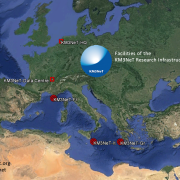The KM3NeT research infrastructure comprises a network of neutrino detectors in the depths of the Mediterranean Sea along the south coasts of Europe. Its data repository and data processing centres are in France and Italy.
KM3NeT is a Research Infrastructure with a cabled network of deep-sea neutrino detectors in the Mediterranean Sea. The neutrino detectors consist of large dimensional arrays of optical modules – pressure resistant glass spheres with ultra-fast and very sensitive photo-sensors. The optical modules are supported by mechanical structures called detection units. The detection units anchored in the deep-sea are linked to shore with a network of cables for electrical power and high-bandwidth fibre data communication. On shore, control stations are equipped to provide power, computing facilities and a high-bandwidth internet connection to the central data repository.
Locations of the KM3NeT Research Infrastructure
During the design study three suitable deep-sea sites are identified, namely going from west to east, KM3NeT-Fr, off-shore Toulon (France), KM3NeT-It, off-shore Portopalo di Capo Passero (Italy) and KM3NeT-Gr, off-shore Pylos (Greece). Detector construction of ARCA in KM3NeT-It and ORCA in KM3NeT-Fr is well on its way. Data are continuously streamed via the public internet to the data repository and computing centres in Lyon, Bologna and in South-Italy.
Phases of construction
The first phase of construction of the KM3NeT Research Infrastructure begun in 2015 at the KM3NeT-It and KM3NeT-Fr site. For this, a Memorandum of Understanding for collaboration in the implementation of KM3NeT-phase1 was signed by all participating funding authorities. For the next construction phase a Letter of Intent for KM3NeT 2.0 has been published, followed by a new Memorandum of Understanding signed by the funding authorities. Currently, the full configuration of KM3NeT 2.0 is partially funded. The final phase of construction of the KM3NeT Research Infrastructure beyond KM3NeT 2.0 will also include the KM3NeT-Gr site.
Synergy
Thanks to the location of the KM3NeT detectors in the Mediterranean and the continuous communication to shore, there is significant synergy with Earth and Sea scientists, in particular with scientists using the EMSO infrastructure.


